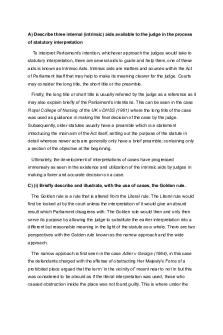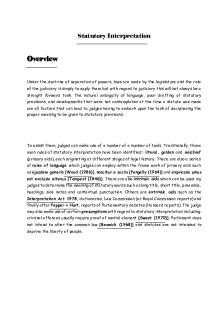Statutory Interpretation 70102 PDF

| Title | Statutory Interpretation 70102 |
|---|---|
| Course | Foundations of Law |
| Institution | University of Technology Sydney |
| Pages | 5 |
| File Size | 218.8 KB |
| File Type | |
| Total Downloads | 50 |
| Total Views | 143 |
Summary
Statutory Interpretation Task...
Description
UTS:Law Assignment Cover Sheet for Online Submissions
Instructions for students:
Please complete and include this cover sheet when submitting online assignment.
The cover sheet should become page 1 of your assignment – do NOT submit this coversheet as a separate document to your assignment.
Please note that by submitting this form you are agreeing to the following ACADEMIC HONESTY DECLARATION:
ACADEMIC HONESTY DECLARATION
I confirm that I am aware of the University rules regarding plagiarism and academic misconduct.
I confirm that this assignment is entirely my own work and I have not previously submitted any part of it for assessment at UTS or any other institution.
I confirm that I have read and understood the current version of the UTS:Law Guide to Written Communication.
STUDENT DETAILS (to be completed by student) Student Number:
Given Name(s): Subject Number:
70102
Subject Name:
FOUNDATIONS OF LAW
Subject Coordinator:
JANE WANGMANN
Word Count:
1620
Date of Submission:
S2016_Sept_v3
Statutory Interpretation Task- 70102
Part A- Locating the legislative provisions 1. The relevant provision for strangulation in NSW is Section 37 of Crimes Act 1900 (NSW).1In QLD, the provisions are under Sections 315 and 315A of the Criminal Code 1899 (QLD).2
2. The NSW provision was last amended on 5th June 2014. The Section 315A QLD provision was inserted on 5th May 2016.
3. The NSW amending act is the Crimes Amendment (Strangulation) Act 2014 (NSW) and the amendments commenced on assent on 5th June 2014. The QLD amending act is the Criminal Law (Domestic Violence) Amendment Act 2016 (QLD), this also commenced on assent on 5th May 2016.
4. To locate the NSW and QLD strangulation provisions, I used the UTS library database and searched for strangulation on LawOne. There it easily linked me to s.37 Crimes Act (NSW). In order to find the QLD provision I specified the jurisdiction I wanted to search for as it related to strangulation, and it linked me to both the principal act and the amending act. When finding both amending acts and the dates of the latest amendments, I searched for strangulation amendment on LawOne and specified the jurisdiction. After finding the Act, on the top right hand of the page there is an icon that reads ‘Key Info’. Once I clicked on that it showed information on currency of the Act and the date of assent. It even has an option to view the original source of the Act, and I could confirm the commencement dates.
Part B- Interpreting the provisions 1. For the NSW statutory provision on strangulation, the elements that need to be proved beyond reasonable doubt are stated in s.37(1) and s.37(2) respectively. 3 These are alternative elements to be proven based on the nature of the offence. Section 37(1a) provides that the choking, suffocation or strangulation must have been intentional and resulted in unconsciousness, insensibility or incapacity to resist in the other person. According to s.37(1b), the accused must be reckless in committing the act. Alternatively, s. 37(2a) establishes choking, suffocation or strangulation must have occurred resulting in the other person’s unconsciousness, insensibility or incapacity to resistance. In s.37(2b) 1 Crimes Act 1900 (NSW) s. 37. 2 Criminal Code 1899 (QLD) s. 315 and s.315A. 3 Crimes Act 1900 (NSW) s. 37(1) and s.37(2). S2016_Sept_v3
it must be proved the act was done to enable the accused to commit, or assist another person to commit another indictable offence.
a. R v O’ Connor [2014]4 and R v Peifeng Yu [2016]5 are recent cases handled under the NSW provision. The latter case involves persons in a domestic relationship. I used Westlaw to find these cases and I typed the search query ‘choking’ in the text box and refined my search to find NSW cases. I scrolled through the results until I could find cases with catchwords that handled non-fatal strangulation and at least one that involved persons in a domestic relationship.
2. The QLD statutory provision for non-fatal strangulation in a domestic setting is covered under s.315A of the QLD Criminal Code.6 The elements to be satisfied for the offence are that the accused must have unlawfully choked, strangled or suffocated the victim without his/her consent.7In addition, the victim and accused must either be in a domestic relationship or the act committed is domestic violence associated with the QLD Domestic and Family Violence Protection Act 2012. 8 Assault is not included as an element in the Act.9
a. According to my research there are no reported decisions on this new provision. However, I was able to find a decision from the QLD Court of Appeal and one from the QLD Supreme Court which both dealt with the provision. I used Casebase and Westlaw to attempt to find reported decisions, however, only unreported decisions and cases pre-dating the provision were found. On both databases, I entered search queries such as ‘strangulation’, choking’ and ‘suffocation’. I also specified the jurisdiction and entered the provision. Following that, I searched exclusively for reported decisions but couldn’t find any. The cases I found are Ackland v Director of Public Prosecutions (Qld) [2017]10 and EFN v Lehmann [2017]. 11
b. I found the explanatory speech of the Bill by entering the title of the Bill on LawOne. Once I found the Bill, I clicked on the ‘Key info’ icon on the top right and there was a link to the explanatory speech. i.
The purpose of the amendment in the explanatory speech is to stop domestic violence in the community and reform the way the QLD government responds to domestic and family violence cases.12
4 R v O’ Connor (2014) NSWCCA 53. 5 R v Peifeng Yu (2016) NSWDC 257. 6 Criminal Code 1899 (QLD) s. 315A. 7 Criminal Code 1899 (QLD) s. 315A(1). 8 Ibid. 9 Criminal Code 1899 (QLD) s. 315A(2). 10 Ackland v Director of Public Prosecutions (Qld) (2017) QCA 75. 11 EFN v Lehmann (2017) QSC 77. 12 Explanatory Speech, Criminal Law (Domestic Violence) Amendment Bill (No 2) 2015 (QLD). S2016_Sept_v3
The amendment notes increased blame on the offender by introducing aggravating circumstances that will increase the maximum penalty and also creates the specific offence of strangulation. The creation of this offence is due to increasing prevalence of strangulation in domestic settings, the serious nature of the offence and a need to deter this sort of violence. Strangulation is seen as being conducive to increased domestic violence offending that could lead to homicide13. The amendment seeks to ensure that offenders are charged and extensive support is given to victims. As strangulation can encompass a range of conduct, there were differing views amongst stakeholders on how legislation should address it. As such, it was important to keep the application of the offence to a domestic setting, and amend the Criminal Code to reflect that. The amendment holds that any person who chokes, suffocates or strangles another person without consent in a domestic setting is liable for a maximum penalty of seven years imprisonment.
Part C- Locating, reading and evaluating secondary sources 1. The two scholarly articles I found were published by the Sydney Law Review and the American Bar Association respectively. The article I located first is titled ‘Strangulation, Domestic Violence and the Legal Response’.14 I identified this article by using the Westlaw database through searching the term ‘strangulation NSW’, and this article was one of the first results to appear. I couldn’t access the source directly from there, so I searched the title on Google and found the original Sydney University PDF version. The second article I found is titled ‘On the Edge of Homicide: Strangulation as a Prelude’15. I noticed the first article I found made reference to this, and decided to search for this paper to see if I could use it. I used the UTS library website to search for scholarly articles and I entered the title of this paper to find it.
2. I believe both sources would help in writing an assignment on whether a non-fatal strangulation provision relating to domestic violence should be included in NSW legislation. This is because both sources are published by influential and reputed organisations like the Sydney Law Review and American Bar Association. Both articles make reference to numerous cases from Australia and the United States involving domestic non- fatal strangulation, as well as many legal and medical studies highlighting the seriousness of such an offence, its impact on victims and the need for it to be properly monitored and controlled. These two sources also demonstrate that this offence can lead to more serious outcomes and needs greater enforcement in all jurisdictions. As such, I found these articles to be persuasive and they showed a good level of academic discourse.
3. The Douglas and Fitzgerald article assesses the implications of non- fatal strangulation and considers legal responses as they exist in Australia, Canada and United States. It analyses cases 13 Ibid. 14 Heather Douglas and Robin Fitzgerald, ‘Strangulation, Domestic Violence and the Legal Response’ (2014)
36 Sydney Law Review 231-254. 15 Gael B Strack and Casey Gwinn, ‘On the Edge of Homicide: Strangulation as a Prelude’ (2011) 26(3) Criminal Justice 32- 36. S2016_Sept_v3
and medical data and examines how applications for protection orders are responded by courts and police and ways that offenders are prosecuted. It looks at provisions in Canada, UK and United States and how it can guide Australian legislation. The article determines that risk of death is high and law reform in Australian jurisdictions should address this to minimise harm and provide support for victims. It also notes that NSW law makes only one mention of strangulation and many cases are charged as sexual assault cases.16 Provisions in other Australian jurisdictions are very similar. However, except Queensland, no other Australian jurisdiction includes strangulation in domestic violence legislation.17 The detailed approach of the authors in considering other jurisdictions and examining a range of studies creates a compelling case for a NSW provision, as it is such a serious and pervasive issue. The Strack and Gwinn article assesses the seriousness of a real life case and the responses to it. It draws on expert medical evidence to argue how strangulation may be a catalyst for a homicide and the fact that it is such a common form of domestic violence in the United States. Due to the high potential for lethality, the article notes tougher penalties for offenders and that many US states have responded with strangulation legislation.18The article is effective at demonstrating that expert evidence has led to law reform in domestic violence and it has been useful in educating the criminal justice system on the dangers of strangulation and how to identify it.
16 Heather Douglas and Robin Fitzgerald, ‘Strangulation, Domestic Violence and the Legal Response’ (2014) 36 Sydney Law Review 231-254. 242, 243. 17 Ibid, 245. 18 Gael B Strack and Casey Gwinn, ‘On the Edge of Homicide: Strangulation as a Prelude’ (2011) 26(3)
Criminal Justice 32- 36. 35. S2016_Sept_v3...
Similar Free PDFs

Statutory Interpretation 70102
- 5 Pages

Statutory Interpretation
- 6 Pages

Statutory Interpretation
- 6 Pages

Statutory Interpretation
- 3 Pages

Statutory Interpretation
- 5 Pages

Statutory Interpretation
- 11 Pages

Statutory Interpretation
- 6 Pages

Statutory interpretation notes
- 2 Pages

Statutory Interpretation in Malaysia
- 12 Pages

Statutory Interpretation Notes
- 9 Pages

Statutory Interpretation Notes
- 4 Pages
Popular Institutions
- Tinajero National High School - Annex
- Politeknik Caltex Riau
- Yokohama City University
- SGT University
- University of Al-Qadisiyah
- Divine Word College of Vigan
- Techniek College Rotterdam
- Universidade de Santiago
- Universiti Teknologi MARA Cawangan Johor Kampus Pasir Gudang
- Poltekkes Kemenkes Yogyakarta
- Baguio City National High School
- Colegio san marcos
- preparatoria uno
- Centro de Bachillerato Tecnológico Industrial y de Servicios No. 107
- Dalian Maritime University
- Quang Trung Secondary School
- Colegio Tecnológico en Informática
- Corporación Regional de Educación Superior
- Grupo CEDVA
- Dar Al Uloom University
- Centro de Estudios Preuniversitarios de la Universidad Nacional de Ingeniería
- 上智大学
- Aakash International School, Nuna Majara
- San Felipe Neri Catholic School
- Kang Chiao International School - New Taipei City
- Misamis Occidental National High School
- Institución Educativa Escuela Normal Juan Ladrilleros
- Kolehiyo ng Pantukan
- Batanes State College
- Instituto Continental
- Sekolah Menengah Kejuruan Kesehatan Kaltara (Tarakan)
- Colegio de La Inmaculada Concepcion - Cebu




